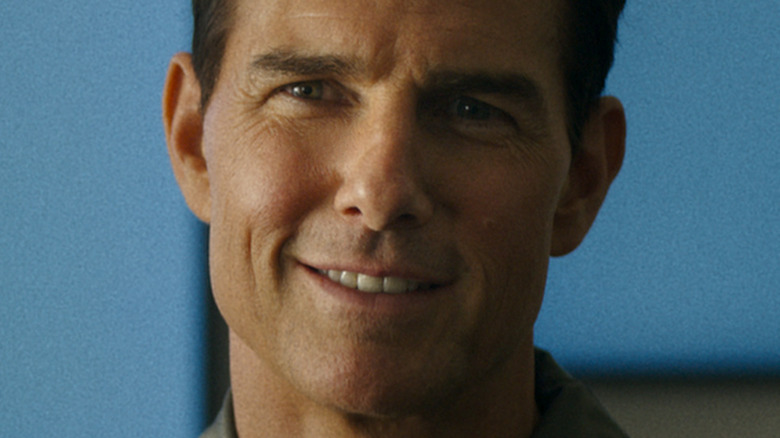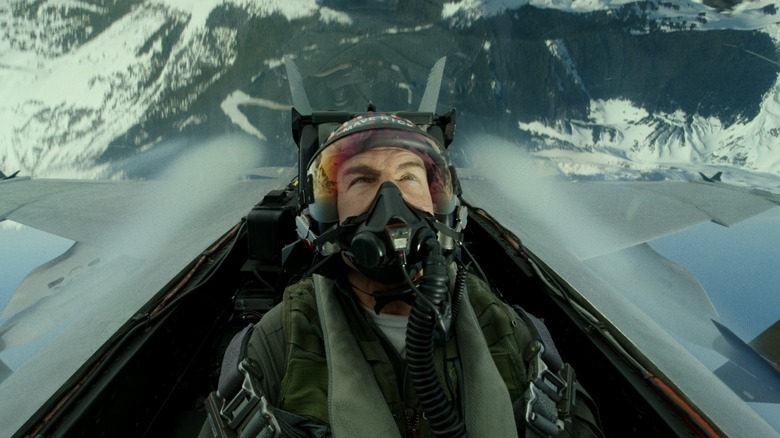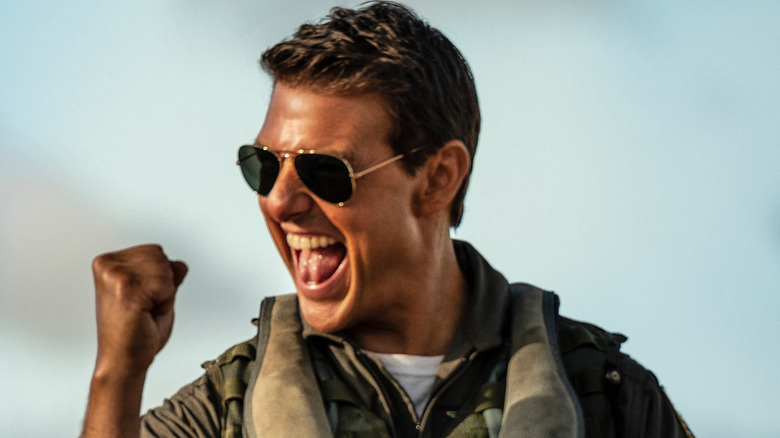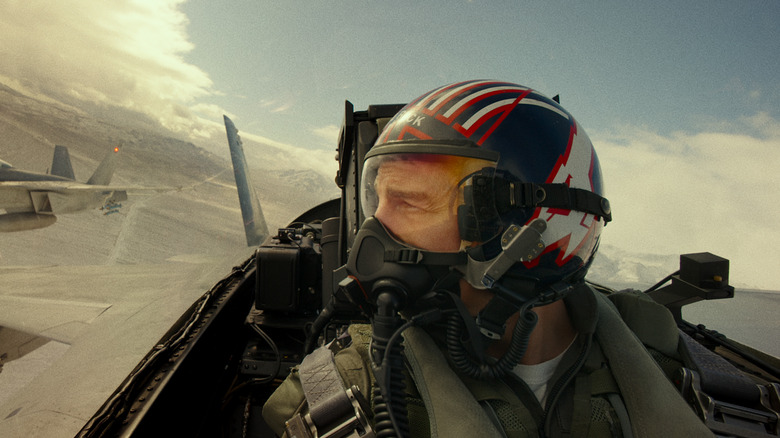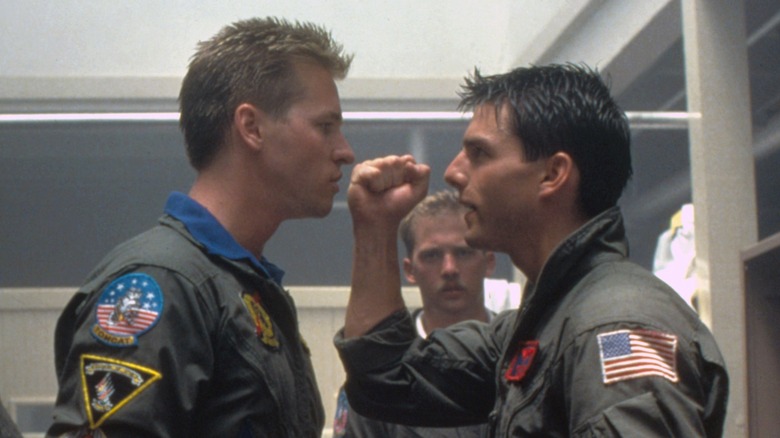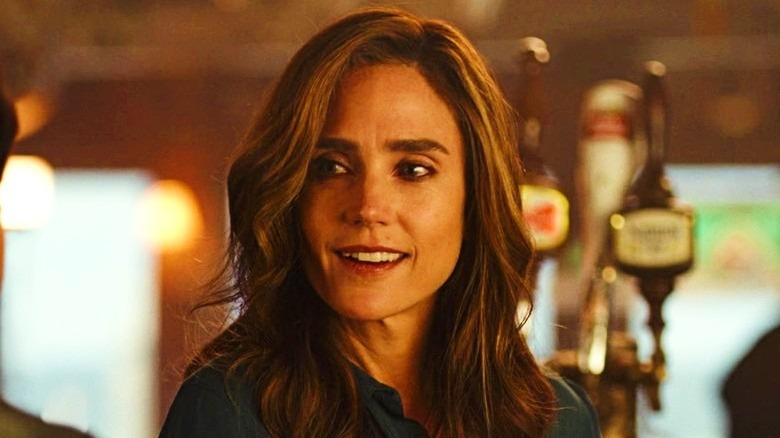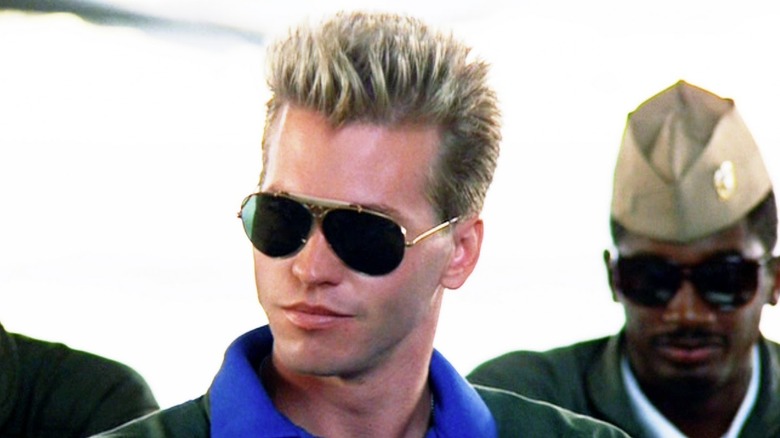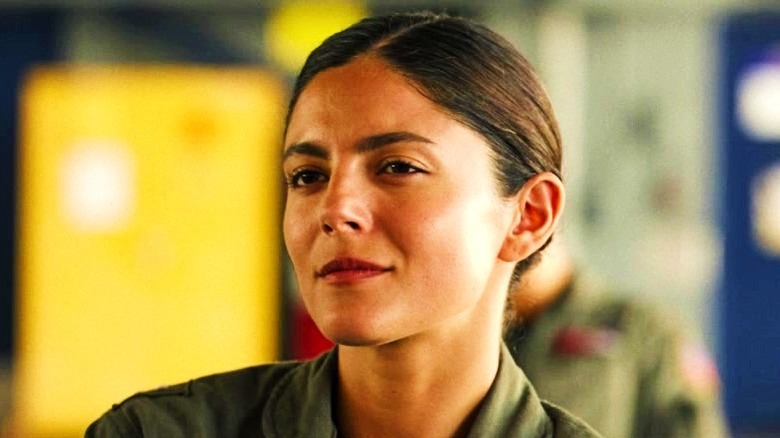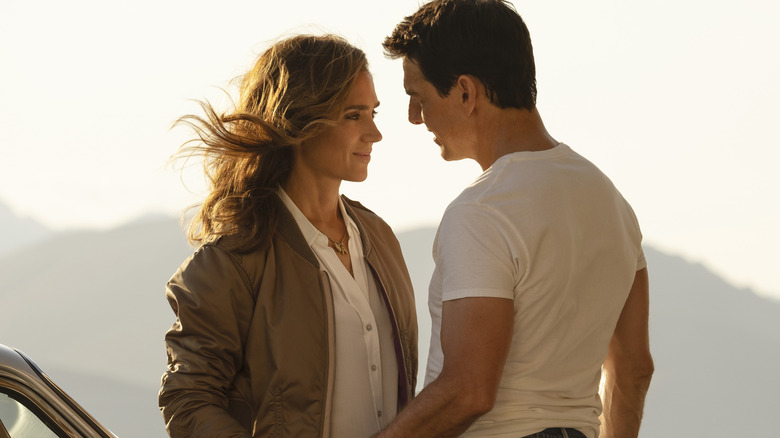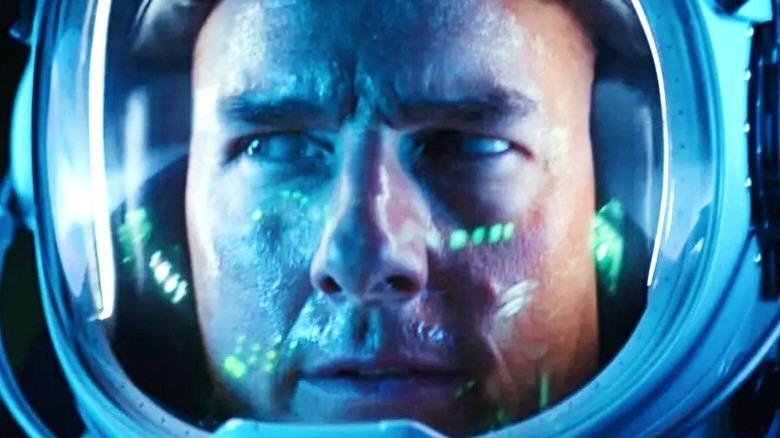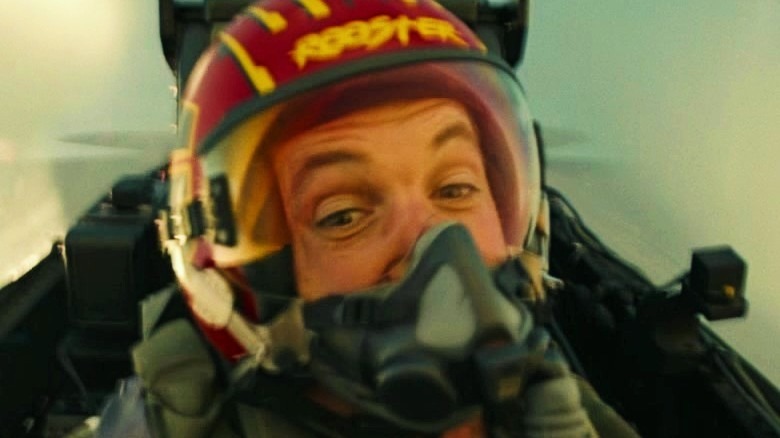10 Reasons Why Top Gun: Maverick Is Better Than The Original
Legacy sequels to already beloved film franchises can be hit or miss, to say the least. This style of rebooting older intellectual properties has become more popular than ever in Hollywood with box office hits like "Star Wars: The Force Awakens," "Ghostbusters: Afterlife," and the newest "Halloween" trilogy all proving that this formula works. Out of all these legacy sequels to grace the silver screen, there's one that has soared above many others in both critical acclaim and financial gain: "Top Gun: Maverick."
The first "Top Gun" is widely considered a classic of 1980s action cinema, cementing the stardom of leading man Tom Cruise and becoming a commercial success upon release. It made over $350 million worldwide and was the year's highest-grossing film. "Top Gun" has earned its place as a fun, over-the-top, and easily parodied blockbuster. That's why it was surprising it took so long for a sequel to get made; "Top Gun: Maverick" released in 2022, 36 years after its predecessor.
"Top Gun: Maverick" takes everything that worked about the original film and dials it up to Mach 10 by pushing the limits of action, adventure, and high-stakes aerial combat. Directed by Joseph Kosinski, this film has proven itself to be an improvement upon the first movie by bringing Cruise's penchant for action back into the skies. Read on to find out all the reasons why "Top Gun: Maverick" is better than the original.
Better jet fighting
Back in 1986, "Top Gun" blew audiences away with its exciting — but (in retrospect) primitive — jet-fighting scenes. The film's production team spared no expense when it came to recording actual U.S. Navy fighter planes to use in the movie, with Paramount Pictures shelling out for them to use F-14 aircraft. According to American Cinematographer, director Tony Scott mounted Super 35mm cameras to the F-14s in order to record dynamic stunts in the air.
While the original movie was impressive for the time, there's arguably no denying "Top Gun: Maverick" goes above and beyond in outdoing its predecessor. This sequel put dogfighting at the center of the story, building up the narrative around a seemingly impossible combat mission that Maverick's students need to master ahead of time. Director Joseph Kosinski and his crew made the most of the film's $170 million budget when crafting the action setpieces. According to Bloomberg, the film's production paid $11,374 per hour of flight to the U.S. Navy for use of their F/A-18E and F/A-18F fighters. The actors pushed themselves to the limit by doing a 3-month training course to prepare their bodies for the overwhelming g-force they'd endure while filming. The result of all this is that "Top Gun: Maverick" has significantly more realistic, exciting, and gorgeously-shot jet-fighting sequences than the original.
Tom Cruise goes all in
Tom Cruise is considered by many to be one of the last true movie stars around and has gained a reputation for being an adrenaline junkie. He has starred in some of the biggest action movies of the past few decades by always diving headfirst into doing his own stunts whenever possible for maximum immersion. With incredible films under his belt like "Jack Reacher," "Edge of Tomorrow," and "Mission: Impossible – Fallout," it is clear that Cruise knows how to make an exciting action movie.
In order to return to the character of Captain Pete "Maverick" Mitchell, Cruise went all-in on bringing this sequel to life. He was instrumental in the production in several ways. Cruise fought for Val Kilmer to return as Iceman in "Top Gun: Maverick"; Kilmer was diagnosed with throat cancer in 2015. Additionally, he not only designed a 3-month training program for his fellow actors but also helped coordinate the film's breathtaking aerial stunts. During an interview with the Independent, Cruise touched on exactly what he and his fellow actors would be doing for the shoot. He said, "We worked with the Navy and the 'Top Gun' school to formulate how to shoot it practically ... because if we're gonna do it, we're gonna fly in the F-18s."
Exciting final mission
While the original "Top Gun" had a fun conclusion culminating in the destruction of four hostile MiG fighters (three by Maverick himself, and one by Iceman), it lacked the stakes and buildup of the final mission in "Top Gun: Maverick." Writers Ehren Kruger, Eric Warren Singer, and Christopher McQuarrie took an original story by both Peter Craig and Justin Marks then polished it into a truly spectacular moviegoing experience.
The plot of the first "Top Gun" was focused on the training of hotshot pilot Pete "Maverick" Mitchell as he butts heads with his supervisors and fellow Top Gun graduates. After Maverick suffers a personal tragedy through the death of his best friend Goose, the film ends with a redemption mission where Maverick and his team defeat enemy pilots together. While this is a fun story, it arguably doesn't hold a candle to what happens in "Top Gun: Maverick." The sequel doubles down on the aerial action by having Maverick return to train the next generation of Top Gun pilots for a very specific mission. In order to destroy an unsanctioned uranium enrichment facility in an unnamed hostile nation, Maverick and his students must flawlessly execute a precision strike through treacherous mountains guarded by high-tech anti-air weapons. One of the most exciting movie moments of the year happens after this, when Maverick is shot down and, along with his protégé Rooster, must steal an outdated enemy F-14 to escape.
Less behind-the-scenes drama
It's no secret some of the original "Top Gun" actors didn't get along with each other during filming. Because of the competitive dynamic of the characters, actors like Val Kilmer and Tom Cruise allowed their on-screen rivalry to bleed into real life. According to Kilmer in the documentary "Val" (via CinemaBlend), he went full method in order to breathe more depth into the character of Iceman. He said, "I would purposely play up the rivalry between Tom's character and mine off-screen as well. And what ended up happening is the actors, in true method fashion, split into two distinct camps. You'd have Maverick and Goose on one side, and Slider, Hollywood, Wolfman, and me, Iceman, on the other."
Additionally, Kilmer revealed in his book "I'm Your Huckleberry: A Memoir" that Cruise was distant from the rest of the cast. He said, "Tom refrained from our revelry, with good reason. From day one, he was laser-focused on a singular goal: to become the greatest action hero in the history of film." While all this was mostly in good fun, it seems like a totally different experience from what the cast of "Top Gun: Maverick" went through as they all trained together as a cohesive unit. Plus, Val Kilmer and Tom Cruise's reunion on the set of the sequel was apparently a very cathartic affair, with both men happy to see each other.
Penny is a really well-developed character
One of the biggest losses between "Top Gun" and "Top Gun: Maverick" was the filmmakers' decision to not include a breakout star from the original: Kelly McGillis as Charlie Blackwood. McGillis brought an incredible performance to the role that elevated her above the usual love interest of '80s movies since her character was also an influential instructor at Top Gun. In fact, Blackwood was directly based on a real person named Christine Fox, who has had an impressive career with the U.S. Navy and the Department of Defense.
Kelly McGillis being left out of "Top Gun: Maverick" is a shame, especially since she's been open about the reasons she wasn't asked to come back. Yet, it is arguably undeniable that a huge highlight of this sequel is the character who fills the void: Penelope "Penny" Benjamin (Jennifer Connelly). Penny has an interesting backstory and complex relationship with Maverick that perfectly fits within this later stage of their lives. Interestingly, her character was set up in the first "Top Gun" during a throwaway line about an admiral's daughter.
Touching plot with Val Kilmer
While Tom Cruise and Val Kilmer may not have had the best experience together on the original "Top Gun" set, they've grown to respect each other as professionals. Not only did Cruise insist Kilmer be in "Top Gun: Maverick," but an entire emotionally-charged plotline was included in the story to mirror the real-life events surrounding Kilmer's throat cancer diagnosis. After all, Kilmer put it best himself in an Instagram post to Cruise where he simply said, "36 years later ... I'm still your wingman."
In "Top Gun: Maverick," Kilmer's character Iceman has endured similar hardships since he, too, has throat cancer. The dynamic between Maverick and Iceman has changed in recent years since the latter has been promoted to Admiral (a position that he uses to keep the heat off his old rival-slash-friend). Much like Kilmer in real life, Iceman is no longer able to easily speak and must instead use text for communication. An emotional climax in the film comes from Iceman's heartbreaking death along with his final message for Maverick: "It's time to let go." For a series that was previously known for over-the-top action and Kenny Loggins songs, the emotional growth of these characters and the maturity of the script in handling Kilmer's illness is a touching element of this film.
Top Gun is finally co-ed
Aside from Kelly McGillis' character of Charlie Blackwood, the first "Top Gun" was undeniably a boys club. The entire cast of expert pilots was played by men including Tom Cruise, Val Kilmer, Anthony Edwards, Tom Skerritt, John Stockwell, and Tim Robbins. Any other female characters in the film are relegated to love interests with barely any screen time, such as Meg Ryan as Goose's wife Carole Bradshaw. With all this in mind, it was a welcome change of pace to see the school had become co-ed for "Top Gun: Maverick."
Although Tom Cruise and Miles Teller are the leading performers of "Top Gun: Maverick," the ensemble cast has been beefed up with a number of female characters who play an important part in the success of their mission. The biggest and most notable addition to the cast is Monica Barbaro as LT Natasha Trace (callsign: Phoenix). During an interview with A.V. Club, she touched on how important this role was to her as she wanted to represent the women of the U.S. Navy. She said, "She's another naval aviator amongst this group. And I was lucky to have some incredible pilots to learn from in that respect. And I asked them those questions and they said the same thing — 'We're just striving for the day when we're not female aviators, but we're just aviators.'" Along with Jennifer Connolly's Penny, these two women really enhance the narrative of the sequel in amazing ways.
Critics couldn't get enough of Maverick
1986's "Top Gun" may have been a box office success, but it wasn't exactly loved by critics at the time. One infamous review by legendary film critic Roger Ebert lambasted the movie as a mostly dull affair with the occasional dogfight to spice things up. In his 2-and-a-half-star review, he said, "Movies like 'Top Gun' are hard to review because the good parts are so good and the bad parts are so relentless." This was unfortunately a common sentiment of critics since the film still has only a 58% score on Rotten Tomatoes, but luckily the filmmakers took these critiques to heart for the sequel.
"Top Gun: Maverick" is a departure from the previous film in that it puts just as much investment into the dialogue and characters as it does the high-speed action. Much more of the film's runtime is devoted to the complex interactions between an aging Maverick and his younger (and hotheaded) students. The dynamic between him and Rooster, Goose's bitter son, is particularly compelling for audiences to watch. In her 4-star review for RogerEbert.com, Tomris Laffly noted how the emotional core actually works. She said, "Equally worthy of that big screen is the emotional strokes of 'Maverick' that pack an unexpected punch." There's a reason this movie boasts an excellent 96% on Rotten Tomatoes in addition to making over $1.4 billion at the box office.
Homages to what came before
Part of what makes "Top Gun: Maverick" so great is that it takes what was already awesome from the first movie and brings it back in exciting new ways. There are iconic aspects of "Top Gun" that fans were expecting to appear in the sequel, and the production team completely delivered. One of the biggest examples of this has got to be the film's opening sequence which, similar to the original, begins with a montage of thrilling real-life operations on board a U.S. Navy aircraft carrier set to "Danger Zone" by Kenny Loggins.
Although it may seem like a remake of the original sequence, it is more like an homage to what came before but with the updated veneer of modern jet fighter operations. "Top Gun: Maverick" also pushes the boundaries of what the series has always been focused on: really fast airplanes. A huge part of this story is how Pete "Maverick" Mitchell's obsession with flying led him to become a dangerous test pilot in the first film. In an attempt to push past Mach 10 in an advanced hypersonic plane, he shows that he's still the same rule-breaking rebel that he's always been.
More advanced filming techniques
Thanks to the progression of camera technology in the decades since 1986's "Top Gun," it's clear just from watching its sequel how far filmmaking has come as an art form. Fans and critics alike have noted how the dogfighting spectacle of "Top Gun: Maverick" is a jaw-dropping experience unlike anything that's been seen in movies for quite some time. Due in no small part to Tom Cruise's personal obsession with doing real stunts whenever possible, this legacy sequel broke new ground in filming aerial combat action that arguably puts even the original movie to shame.
In order to perfectly film all the necessary fighter jet footage, the production team for "Top Gun: Maverick" went so far as sticking high-tech cameras right inside the cockpits with real Navy pilots. According to behind-the-scenes footage (via Y.M. Cinema Magazine), they used extremely powerful IMAX-certified Sony Venice 6K Full Frame cameras that were set up to have two cameras pointed outside the cockpit, and four facing the actor to record their reactions. In an interview with Den of Geek, director Joseph Kosinski explained all the hoops they had to jump through to shoot it properly and why that was necessary. He said, "You can feel the strain, the g-forces, the speed, something you could never capture on a soundstage, no matter how much money or visual effects you threw at it." Kosinski made sure to highlight all the hard work that went into shooting "Top Gun: Maverick" realistically, which paid off in the end.
